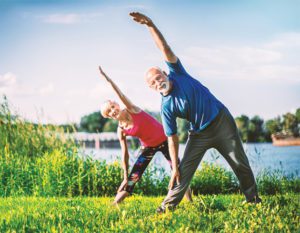By Dr. John C. Kagan, M.D.
 As we grow older, we begin to lose bone tissue and muscle mass. Accompanying these changes is an increase in the delicacy of our bones and a decrease in overall muscle strength. As this occurs, we can become at risk of developing bone conditions such as osteoporosis, which causes bones to become weak or brittle. In addition, when the muscles surrounding the joints weaken, greater strain is placed on the joints, which can cause the protective cartilage that cushions the bones to break down, causing joint inflammation and increasing the risk of osteoarthritis.
As we grow older, we begin to lose bone tissue and muscle mass. Accompanying these changes is an increase in the delicacy of our bones and a decrease in overall muscle strength. As this occurs, we can become at risk of developing bone conditions such as osteoporosis, which causes bones to become weak or brittle. In addition, when the muscles surrounding the joints weaken, greater strain is placed on the joints, which can cause the protective cartilage that cushions the bones to break down, causing joint inflammation and increasing the risk of osteoarthritis.
In order to maintain overall health and independence as we age, it is essential to care for the health of our bones and joints by taking steps to remain active, and keeping our bodies both healthy and happy throughout the various stages of aging. Although the fragility of bones and joints increases as we age, many of the changes in muscles, joints and bones are due to lack of use, rather than simply getting older. Preventative steps can be taken reduce the risk of injury or development of arthritis. Below are three steps to help maintain optimal bone and joint health:
• Exercise regularly. Thirty minutes of daily physical activity can not only help you feel better, it can also help in the prevention of some medical conditions. Exercise is very important to keep the joints flexible, the muscles around the joints strong, and the bone and cartilage tissue healthy. A balanced fitness program should incorporate aerobic, strengthening and range-of-motion exercises.
• Get your recommended value of Calcium and Vitamin D. Calcium is essential to maintain strong bones and teeth, and must be absorbed from your dietary intake. Sources of calcium include green leafy vegetables, milk and other dairy products, salmon, almonds, tofu and any food products fortified with calcium. Vitamin D is important for bone health because it aids the body’s absorption of calcium.
• Know your body. If you have had fractures in the past, you are at a greater risk of having them reoccur. Reduce your risk of falls and fractures by having your physician check your eyesight, prescription medications and balance to assess your risk of falls, and ask for tips that will help you prevent falls that can lead to broken bones and aching joints.
In addition, always be cautious when adding activities and new exercises into your fitness routine. New fad exercises might be fine for younger people. Don’t forget, your body parts have some mileage on them. Whether you are new to the fitness scene, or are in good physical shape, do not try to take on too may activities at once. Be sure to consult an orthopedic surgeon who can advise you for an appropriate form of exercise for your age group.
Edward R. Dupay, Jr, DO
Board Certified
Dr. Dupay graduated from Xavier University in Cincinnati, Ohio. He received his Doctor of Osteopathy at the University of Health Sciences, College of Osteopathic Medicine in Kansas City, Missouri.
Dr. Dupay completed his Internship and Orthopedic Surgery Residency at Flint Osteopathic Hospital in Flint, Michigan. Dr. Dupay has been in the Fort Myers / Cape Coral area since 1987. Dr. Dupay enjoys seeing the “Weekend Warrior” athlete.
239-768-2272 | www.ifixbones.com









